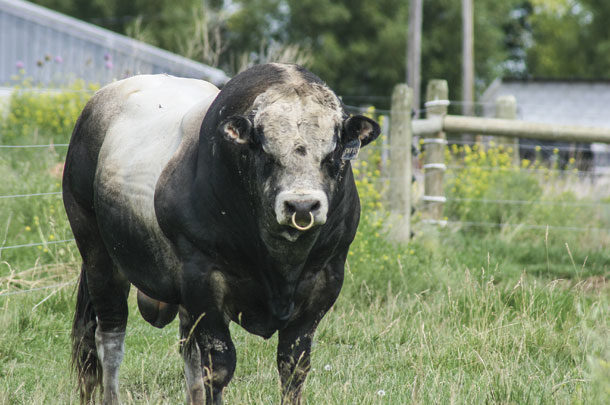There is no existing cable line on the high-voltage electric poles that cross the river and cut through a corner of my calving pasture.
When I got to my chained and padlocked double gates some 2,000 feet from the highway (with a sign that says “Warning, Black Angus Cattle Ahead”), I saw something odd. The orange guy wire protector on the post in front of the bull pen was propped on the paddock gate.
Someone had been in my calving pasture.
Before I drove back out for a chat with the cable guy about who was harassing who, I grained the yearling. But that afternoon, his head came up, and he got in my face as soon as I went in the pen. After a quick jump into the feed bin, I reassessed his night-and-day change in behavior. The ensuing conversation with the cable guy quickly went south when the worker informed me he had the right to access without my knowledge or permission because the cable company had leased pole space from the electric company, and he’d been subcontracted to do the work.
After a phone call to the police about trespass, and breaking and entering, I was advised to contact the electrical cooperative and request a copy of the easement, right of way agreement and any grants of permission that run with the land.
Two days later, the cable company supervisor arrived during feed time. The yearling reacted to the sound of an unfamiliar truck with a hard kick to the inside of my knee.
But that pain-filled expletive was nothing compared to the one I let loose when the supervisor observantly pointed out the only way to put the “pull it across the river wire” up that high on that utility pole was with a bucket truck. A truck set up right in front of my bull pen? Did I mention my gates are chained and padlocked?
In their own words, here is what I learned about grants of permission to access, right of way agreements, and who’s liable for riling up the bull from cattle operations and owners impacted by modern day utility, broadband, oil and gas extraction activities.
As suggested, I started out by calling my cooperative.
Pennsylvania Tri-County Electric: “We will get you a copy of your easement. Any questions you have regarding access notification will have to be directed to the cable company.” – May 17, Steve Salada, engineer. I received the requested easement copy on July 13. We’ve farmed this land since 1908. My local electric cooperative was incorporated in 1936. My grandfather signed the easement in 1937.
Then I called organizations that must deal with this sort of thing. The Pennsylvania Public Utility Commission gave a bureaucratic response: “It’s a complex issue” and paraphrasing now, “It depends on whose utility line it is and what agreements are in place, and we don’t regulate cooperatives.” – July 1, Nils Hagen-Frederiksen, press secretary
So I called down to Tennessee.
Tennessee Farm Bureau: “Your article is very timely. There is a push to expand broadband in rural areas. Over the next few years, they are going to be traipsing through pastures and forests in Tennessee.” – July 1, Stefan Maupin, director, public policy. He also suggested I call the Texas Farm Bureau and find out about recent legislation passed on this very issue.
Texas Farm Bureau: “Is the easement on the pole just for utilities or does it allow broadband?” I spoke to Regan Beck about recent legislation regarding adding broadband service lines onto existing electric cooperative easements. “Senate Bill 14 (SB14) helps expand broadband service into rural areas by allowing the addition of broadband to electric cooperative service infrastructure. The problem is this addition may go beyond the terms of the easement agreement between the landowner and the co-op.
Texas Farm Bureau was able to add an amendment to SB14 that requires electric co-ops to contact property owners before adding broadband to existing easements. If the property owner objects, the electric cooperative may not use the easement for broadband service unless the property owner later agrees in writing. This helps protect property owners from a unilateral action that goes beyond the terms of the easement agreement with the electric co-op.” – July 9, Regan Beck, director, government affairs.
I also did an internet search and found this checklist from the Michigan Farm Bureau - utility easement: “Yes, feel free to use our checklist of right of way questions in your article. We developed this checklist for our members on what to consider when a farmer negotiates a utility easement. So we developed this as talking points to take to your attorney.” – July 9, Matthew Kapp, land stewardship specialist.
My editor suggested I give Jim Bradbury, legal counsel for the Texas Association of Dairymen, a call and get his take on this incident, which I am glad I did: “Too many of today’s subcontractors get it in their head they have special status,” said Bradbury, author of the Texas AgriLife Extension publication titled “Five Strands: A Landowner’s Guide to Fence Law in Texas.” His suggestion on July 26, “Contact the senior utility of the easement in writing, and inform them and any third-party user to set up an access agreement, and have insurance.”
I also wanted to pass along a related cattle health issue occurring in Pennsylvania. “A well was fracked above my dairy barn, and my cows suddenly stopped drinking water, and my milk production plummeted, and cows died.” – Mike Buckwalter, former dairyman, Mansfield, Pennsylvania. Buckwalter is one of several cattle producers in the region who claim their cattle groundwater source was impaired due to fracking activity either on their own land or nearby. The producers I have interviewed want the state to adopt “livestock water quality standards” for oil and gas exploration activities and when contamination occurs, just compensation for the loss of milk, beef and forage production income.
It’s been 82 years since Roosevelt’s Rural Electrification Administration created the Electric Cooperative Cooperation Act. The 1930s linesmen who approached our forbearers about a right of way through our cattle operations probably knew a thing or two about how to work around cattle. With less than 2% of the population engaged in agriculture now, don’t assume the millennial utility, oil or gas worker has any cow or bull sense at all. If you haven’t done this already, get out your easements, and consider the following (see sidebar below). ![]()
PHOTO: Don’t try convincing this big fella that your utility company has an access lease to his pasture. Staff photo.
Editor’s note: The expressed opinions in this article are those of the author Melissa Bravo and do not purport to reflect those of Progressive Cattle magazine.

-
Melissa Bravo
- Certified Crop Adviser – Livestock and Forage Specialist
- Meadow Lake Farm Consulting
- Email Melissa Bravo
Easement and right of way checklist for cattle operations
Lessons learned from rural Pennsylvania
- Require all persons entering right of way to receive basic cattle behavior and herd health safety training.
- Require land and livestock owners be contacted before entering if cows, calves or bulls are present.
- Include protective language about livestock water quality standards before any work begins or resumes.
- Require a veterinarian and state water official be called if livestock suddenly refuse to drink water or behave oddly. Determine who pays for the consult, tests and costs associated with getting cattle back to normal consumption rate.
- Who has responsibility to manage poisonous plants that emerge in the right of way, and who pays for cattle losses? Read Walking the fence: Spring hazards and pasture toxicities.
- Are guy wires, anchors, number, capacity and height of wires installed to prevent animal or livestock handler injury or electrocution?
- Does your existing easement or agreement limit use of the easement by third parties without the grantor’s specific consent?
- Whose duty is it to remove vacated poles, towers, footings, etc. to prevent future injury to livestock or livestock handlers?
- What’s the minimum depth of the subsurface installation and is it designed to prevent animals and their water source location from exposure to stray voltage or lightning strikes?
- Require compensation for time away from work to ensure your cattle investment is protected.
- Require before, during and post site visits by all parties including water quality officials to ensure livestock and their water sources have not been harmed by the exercise of the right of way easement.








